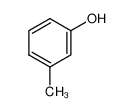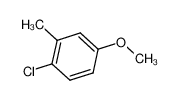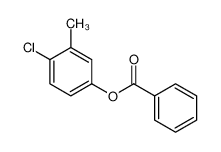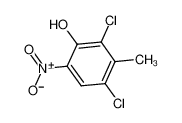

-
4-Chloro-3-methylphenol
CAS No.59-50-7
Formula:C7H7ClO
p-Chlorocresol (p-chloro-m-cresol; PCMC; brand name: Preventol CMK) is a chlorinated phenol which is used as an antiseptic and preservative. It forms colourless, dimorphous crystals at room temperature and is only slightly soluble in water. For use as a disinfectant such as a hand wash, it is commonly dissolved in alcohol in combination with other phenols. It is a moderate allergen for sensitive skin.
Formula
C7H7ClO
Molecular Weight
142.583
Exact Mass
142.019
LogP
2.354
PSA
20.23
Synonyms
Chlorocresol
expand collapse
SDS 1.0
expand
collapse
MSDS
expand
collapse
| Name: | 4-Chloro-m-cresol Material Safety Data Sheet |
| Synonym: | 6-Chloro-3-hydroxytoluene; 4-Chloro-3-methylphenol; Baktol; Chlorocresol; Preventol CMK |
| CAS: | 59-50-7 |
Synonym:6-Chloro-3-hydroxytoluene; 4-Chloro-3-methylphenol; Baktol; Chlorocresol; Preventol CMK
Section 2 - COMPOSITION, INFORMATION ON INGREDIENTS
| CAS# | Chemical Name | content | EINECS# |
| 59-50-7 | 4-Chloro-m-cresol | 100 % | 200-431-6 |
Risk Phrases: 21/22 41 43 50
Section 3 - HAZARDS IDENTIFICATION
EMERGENCY OVERVIEW
Harmful in contact with skin and if swallowed. Risk of serious damage to eyes. May cause sensitization by skin contact. Very toxic to aquatic organisms.
Potential Health Effects
Eye:
Contact may cause severe eye irritation and possible eye damage.
Risk of serious damage to eyes.
Skin:
Harmful if absorbed through the skin. Prolonged and/or repeated contact may cause irritation and/or dermatitis. May cause skin sensitization, an allergic reaction, which becomes evident upon re-exposure to this material.
Ingestion:
May cause liver and kidney damage. Methemoglobinemia is characterized by dizziness, drowsiness, headache, shortness of breath, cyanosis (bluish discoloration of skin due to deficient oxygenation of the blood), rapid heart rate and chocolate-brown colored blood. May be harmful if swallowed. Overexposure may cause methemoglobinemia. Causes gastrointestinal tract irritation.
Inhalation:
Causes respiratory tract irritation. May be harmful if inhaled.
Chronic:
May cause liver and kidney damage. Repeated skin contact may cause dermatitis with dark pigmentation of the skin.
Section 4 - FIRST AID MEASURES
Eyes: Immediately flush eyes with plenty of water for at least 15 minutes, occasionally lifting the upper and lower eyelids. Get medical aid immediately.
Skin:
Get medical aid immediately. Immediately flush skin with plenty of water for at least 15 minutes while removing contaminated clothing and shoes. Wash clothing before reuse.
Ingestion:
Do not induce vomiting. If victim is conscious and alert, give 2-4 cupfuls of milk or water. Never give anything by mouth to an unconscious person. Get medical aid immediately.
Inhalation:
Get medical aid immediately. Remove from exposure and move to fresh air immediately. If not breathing, give artificial respiration. If breathing is difficult, give oxygen.
Notes to Physician:
Section 5 - FIRE FIGHTING MEASURES
General Information:
As in any fire, wear a self-contained breathing apparatus in pressure-demand, MSHA/NIOSH (approved or equivalent), and full protective gear. During a fire, irritating and highly toxic gases may be generated by thermal decomposition or combustion. Vapors may be heavier than air. They can spread along the ground and collect in low or confined areas.
Extinguishing Media:
In case of fire, use water, dry chemical, chemical foam, or alcohol-resistant foam.
Section 6 - ACCIDENTAL RELEASE MEASURES
General Information: Use proper personal protective equipment as indicated in Section 8.
Spills/Leaks:
Vacuum or sweep up material and place into a suitable disposal container. Reduce airborne dust and prevent scattering by moistening with water. Clean up spills immediately, observing precautions in the Protective Equipment section. Avoid generating dusty conditions.
Provide ventilation.
Section 7 - HANDLING and STORAGE
Handling:
Wash thoroughly after handling. Wash hands before eating. Remove contaminated clothing and wash before reuse. Use with adequate ventilation. Avoid contact with skin and eyes. Avoid ingestion and inhalation.
Storage:
Store in a cool, dry place. Keep container closed when not in use.
Section 8 - EXPOSURE CONTROLS, PERSONAL PROTECTION
Engineering Controls:
Facilities storing or utilizing this material should be equipped with an eyewash facility and a safety shower. Use adequate general or local exhaust ventilation to keep airborne concentrations below the permissible exposure limits.
Exposure Limits CAS# 59-50-7: Netherlands: 3 mg/m3 MAC Personal Protective Equipment Eyes: Wear appropriate protective eyeglasses or chemical safety goggles as described by OSHA's eye and face protection regulations in 29 CFR 1910.133 or European Standard EN166.
Skin:
Wear appropriate protective gloves to prevent skin exposure.
Clothing:
Wear appropriate protective clothing to prevent skin exposure.
Respirators:
Follow the OSHA respirator regulations found in 29 CFR 1910.134 or European Standard EN 149. Use a NIOSH/MSHA or European Standard EN 149 approved respirator if exposure limits are exceeded or if irritation or other symptoms are experienced.
Section 9 - PHYSICAL AND CHEMICAL PROPERTIES
Physical State: Solid
Color: white to pale pink
Odor: Odorless.
pH: 6.5 (1 g/l aq. sol.)
Vapor Pressure: 0.08 mm Hg @ 20C
Viscosity: Not available.
Boiling Point: 235 deg C
Freezing/Melting Point: 63-65 deg C
Autoignition Temperature: 590 deg C ( 1,094.00 deg F)
Flash Point: 118 deg C ( 244.40 deg F)
Explosion Limits, lower: Not available.
Explosion Limits, upper: Not available.
Decomposition Temperature: Not available.
Solubility in water: Slightly soluble in water.
Specific Gravity/Density: Not available.
Molecular Formula: C7H7ClO
Molecular Weight: 142.5014
Section 10 - STABILITY AND REACTIVITY
Chemical Stability:
Stable under normal temperatures and pressures.
Conditions to Avoid:
Incompatible materials, dust generation.
Incompatibilities with Other Materials:
Bases, acid chlorides, acid anhydrides, sodium hydroxide, oxidizing agents, steel, brass, copper, and copper alloys.
Hazardous Decomposition Products:
Hydrogen chloride, carbon monoxide, carbon dioxide.
Hazardous Polymerization: Has not been reported.
Section 11 - TOXICOLOGICAL INFORMATION
RTECS#:
CAS# 59-50-7: GO7100000 LD50/LC50:
CAS# 59-50-7: Oral, mouse: LD50 = 600 mg/kg; Oral, rat: LD50 = 1830 mg/kg.
Carcinogenicity:
4-Chloro-m-cresol - Not listed by ACGIH, IARC, or NTP.
Other:
See actual entry in RTECS for complete information.
Section 12 - ECOLOGICAL INFORMATION
Ecotoxicity:
Fish: Fathead Minnow: LC50: 13.3mg/L; 24 HrFish: Fathead Minnow: LC50: 11.4mg/L; 48 HrFish: Fathead Minnow: LC50: 9.21 mg/L; 72 HrDaphnia: Daphnia: EC50: 5.6 mg/L; 24 Hr
Section 13 - DISPOSAL CONSIDERATIONS
Dispose of in a manner consistent with federal, state, and local regulations.
Section 14 - TRANSPORT INFORMATION
IATA
Shipping Name: CHLOROCRESOLS, SOLID
Hazard Class: 6.1
UN Number: 3437
Packing Group: II
IMO
Shipping Name: CHLOROCRESOLS, SOLID
Hazard Class: 6.1
UN Number: 3437
Packing Group: II
RID/ADR
Shipping Name: CHLOROCRESOLS, SOLID
Hazard Class: 6.1
UN Number: 3437
Packing group: II
USA RQ: CAS# 59-50-7: 5000 lb final RQ; 2270 kg final RQ
Section 15 - REGULATORY INFORMATION
European/International Regulations
European Labeling in Accordance with EC Directives
Hazard Symbols: XN N
Risk Phrases:
R 21/22 Harmful in contact with skin and if
swallowed.
R 41 Risk of serious damage to eyes.
R 43 May cause sensitization by skin contact.
R 50 Very toxic to aquatic organisms.
Safety Phrases:
S 26 In case of contact with eyes, rinse immediately
with plenty of water and seek medical advice.
S 36/37/39 Wear suitable protective clothing, gloves
and eye/face protection.
S 61 Avoid release to the environment. Refer to
special instructions/safety data sheets.
WGK (Water Danger/Protection)
CAS# 59-50-7: 2
Canada
CAS# 59-50-7 is listed on Canada's DSL List.
CAS# 59-50-7 is not listed on Canada's Ingredient Disclosure List.
US FEDERAL
TSCA
CAS# 59-50-7 is listed on the TSCA inventory.
SECTION 16 - ADDITIONAL INFORMATION
N/A
Kovats' RI, non-polar column, custom temperature program
expand
collapse
Column Shape
Packed
Active Phase(℃)
SE-30
Retention index
1283.
Temperature Control
Method
custom temperature program
Comments
Chromosorb W HMDS (80-100 mesh); Column length: 2.9 m; Program: not specified
Reference
Grzybowski, J.Lamparczyk, H.Nasal, A.Radecki, A.Relationship between the retention indices of phenols on polar and non-polar stationary phasesJ. Chromatogr.1980, 196, 2, 217-223.
Van Den Dool and Kratz RI, non-polar column, temperature ramp
expand
collapse
Column Shape
Capillary
Active Phase(℃)
VF-5MS
Retention index
1293.
Temperature Control
Method
temperature ramp
Comments
30. m/0.25 mm/0.25 μm, He; T<sub>start</sub>: 60. C; T<sub>end</sub>: 270. C
Reference
Todua, N.G.Retention Data. NIST Mass Spectrometry Data Center.NIST Mass Spectrometry Data Center, 2011.
Van Den Dool and Kratz RI, non-polar column, temperature ramp
expand
collapse
Column Shape
Capillary
Active Phase(℃)
OV-1
Retention index
1260.1
Temperature Control
Method
temperature ramp
Comments
8. K/min; T<sub>start</sub>: 35. C; T<sub>end</sub>: 300. C
Reference
Gautzsch, R.Zinn, P.Use of incremental models to estimate the retention indexes of aromatic compoundsChromatographia1996, 43, 3/4, 163-176.
Van Den Dool and Kratz RI, non-polar column, temperature ramp
expand
collapse
Column Shape
Capillary
Active Phase(℃)
DB-1
Retention index
1277.
Temperature Control
Method
temperature ramp
Comments
30. m/0.235 mm/0.25 μm, N2, 50. C @ 0. min, 10. K/min
Reference
Gerbino, T.C.Castello, G.Prediction of programmed temperature retention indices on capillary columns of different polaritiesJ. Chromatogr. A1995, 699, 1-2, 161-171.
Van Den Dool and Kratz RI, non-polar column, temperature ramp
expand
collapse
Column Shape
Capillary
Active Phase(℃)
DB-1
Retention index
1280.
Temperature Control
Method
temperature ramp
Comments
30. m/0.235 mm/0.25 μm, N2, 50. C @ 0. min, 5. K/min
Reference
Gerbino, T.C.Castello, G.Prediction of programmed temperature retention indices on capillary columns of different polaritiesJ. Chromatogr. A1995, 699, 1-2, 161-171.
1.Synthesis Route
2.Synthesis Route
3.Synthesis Route
Home
> Encyclopedia
> Biochemicals and Pharmaceutical Chemicals
> Pharmaceutical Impurities
> 4-Chloro-3-methylphenol
Related Compound Information
Copyright © 2015 MOLBASE All Rights Reserved.
ICP Shanghai 14014220











